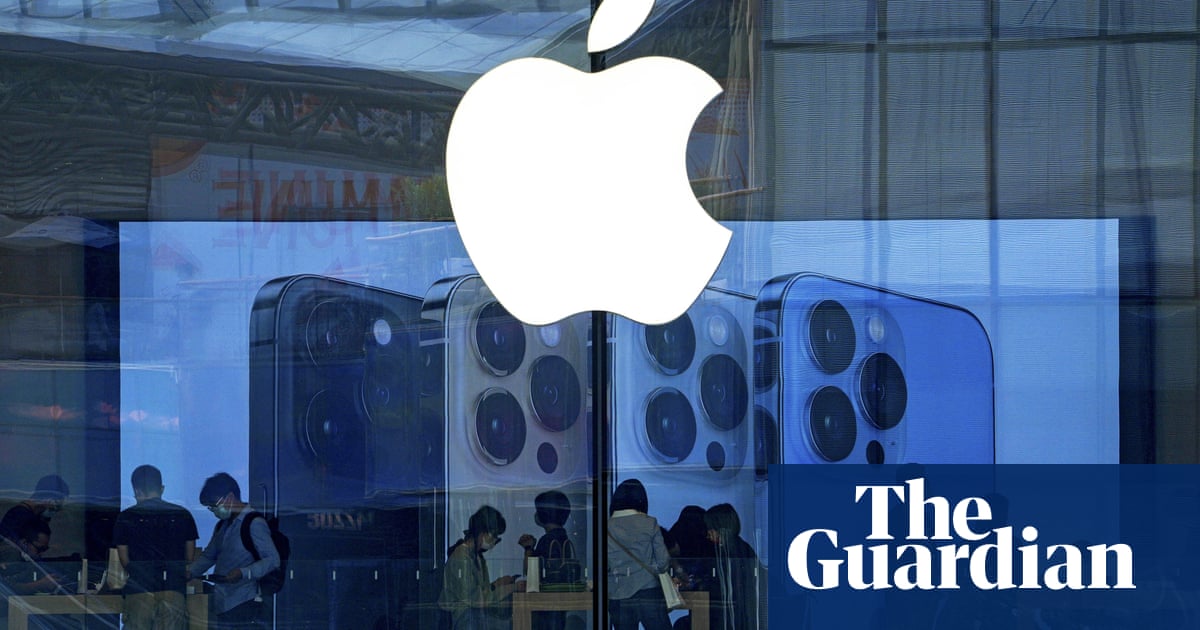Rumours abound over Apple’s ‘far out’ iPhone 14 launch
The invitation to Apple’s latest iPhone launch event on Wednesday, at which the company is expected to reveal new versions of the iPhone and Apple Watch, shows a starfield in the shape of the company’s logo, with the caption “Far out”.
The company’s event invitations frequently contain a gnomic hint at the forthcoming news, usually only visible in the rear-view mirror. But while some of the company’s expected announcements are likely to elicit a sense of amazement, they may not all be in the tone that Apple’s marketing team would hope.
Continuing the pattern set four years ago, its new iPhones are likely to be split into two lines, the iPhone 14 Pro and the adjectiveless, and cheaper, iPhone 14, each available in normal and large sizes. But for the first time since the iPhone 3G release in 2008, some of the new models will reportedly contain the same series of processors, Apple’s A15 Bionic chips, that are already used in the iPhone 13, suggesting that there is unlikely to be a noticeable performance difference between new and old.
While the more expensive iPhone 14 Pro will contain A16 Bionic chips, continuing the company’s long-running approach of debuting new silicon in a new iPhone, the cheaper iPhone 14 won’t, according to reports from the analyst Ming-Chi Kuo. The company has struggled with the chip shortages faced by much of the rest of the industry, as well as supply chain disruption due to continued Covid lockdowns in China and geopolitical tension between Taiwan and Beijing.
Instead of offering faster phones, the new devices are expected to be pitched with another major upgrade: “always-on” screens. Hinted at in the preview of iOS 16, the next version of the operating system for iPhones, the latest devices are likely to have a lock screen that can be dimmed without turning off entirely, enabling the time and notifications to remain always on show.
As well as solving supply constraints, continuing to use the older chip in the cheaper phones would further differentiate the two iPhone lines in the eyes of consumers. When Apple first introduced a higher-tier iPhone model, with the iPhone X, the distinctions between it and the cheaper iPhone 8 were clear, with everything from the screen size, design and presence of Face ID differing. In recent years, though, the distinction has diminished to a minor difference in finish and an extra camera on the more expensive phones – even while the price difference has grown to £270.
But in another way, the two lines of iPhones will become more similar, since Apple is expected to end production of the smaller iPhone mini. First released with the iPhone 12, the mini had a 5.4in screen, compared with 6.1in on standard iPhones and 6.7in on iPhones max.
But while it survived for two years, the company was reportedly disappointed by the sales figures, and will not be bringing the device back for a third year.
The mini was praised for being one of the few phones on the market that allowed people with smaller hands to avoid having to compromise on their technology choices. Although the phone had, of necessity, a smaller battery than the standard iPhones, everything else was the same as its larger siblings.
Caroline Criado Perez, author of Invisible Women, a book about how the world is designed for men, praised the mini on its release, calling it an “indication that the world’s largest tech firm is getting wise to the fact that women not only exist, but also like good tech as much as men”. Now, the company’s smallest phone is likely to be the iPhone SE, which is significantly larger than the iPhone mini.
Apple is also expected to reveal a redesign of the Apple Watch, splitting it into two tiers just like its larger sibling. The “Apple Watch Pro”, reported by Bloomberg’s Mark Gurman, is expected to have a titanium casing and be larger than existing models, with a bigger screen and a more durable design intended to appeal to fans of extreme sports.
The products will launch alongside already-announced software updates, including the latest versions of iOS and macOS, which include new features such as Continuity Camera, which lets people use their iPhones as a webcam. The next version of iPadOS has been delayed, however, and will not be launched alongside the new devices.
As for the “Far out” tagline, there are a few guesses as to what it may portend. One is that the company is planning on launching a long-rumoured feature for emergency satellite connectivity, allowing text alerts to be sent to emergency services even in areas with zero cellular coverage.
Another is that the company might be planning to improve the telephoto lens that now ships in the iPhones Pro, bringing the phone’s 3x zoom up to the 10x or even 40x offered by some competitors such as Samsung or Huawei.











